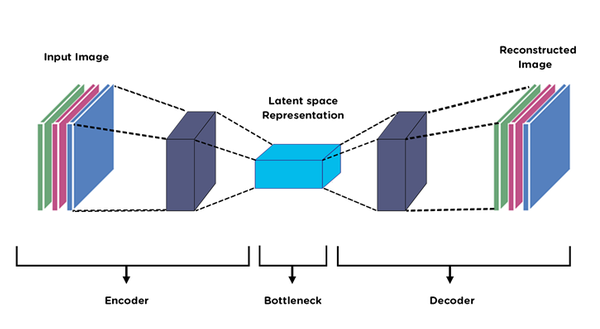Encoding - Decoding
-
인코딩 : 특정 파일을 특정 형태로 변화하는 과정
-
인코더 : 잠재공간과 동일 , 특정 구조화된 값으로 매핑하는 함수
-
디코딩 : 잠재공간에 의해 변형된 파일을 특정 형태로 복원하는 과정
-
디코더 : 구조화된 값을 원래 형태로 복원하는 함수
오토인코더

-
입력을 저차원 잠재공간으로 인코딩한 후 디코딩하여 복원하는 네트워크
즉, 이미지를 입력받아 인코더 모듈을 사용하여 잠재 벡터 공간으로 매핑하고,
디코더 모듈을 사용하여 원본 이미지와 동일한 차원으로 복원하여 출력 -
원본 입력을 재구성하는 방법으로 학습 (원본 입력과 재구성된 자료와의 차이를 비교)
-
고전적인 방식은 구조화가 잘된 잠재 공간을 만들지 못하고,
압축도 뛰어나지 않음
실습
라이브러리, 데이터 가져오기
## 라이브러리
import tensorflow as tf
from tensorflow.keras.datasets import fashion_mnist
from tensorflow.keras.models import Model
from tensorflow.keras.layers import Dense, Flatten, Reshape
from tensorflow.keras.losses import MeanSquaredError
import numpy as np
import matplotlib.pyplot as plt
plt.style.use('seaborn-white')
# 데이터 가져오기
(x_train, _), (x_test, _) = fashion_mnist.load_data()
# 정규화 - normalize
x_train = x_train.astype('float32')/255.
x_test = x_test.astype('float32')/255.
print(x_train.shape)
print(x_test.shape)모델 정의 / 인코더-디코더
latent_dim = 64
class Autoencoder(Model):
def __init__ (self,latent_dim):
super(Autoencoder, self).__init__()
self.latent_dim = latent_dim
# encode - compress
self.encoder = tf.keras.Sequential([Flatten(), Dense(latent_dim,activation='relu')])
#decode - decompress
self.decoder = tf.keras.Sequential([Dense(784,activation = 'relu'), Reshape((28,28))])
def call(self,x):
encoded = self.encoder(x)
decoded = self.decoder(encoded)
return decoded
- 잠재공간을 임의로 64로 지정
Flatten으로 압축Dense로 다시 784로 바꾸고Resahpe으로 형태 변환
모델 생성 및 컴파일
autoencoder = Autoencoder(latent_dim)
autoencoder.compile(optimizer='adam',loss= MeanSquaredError())
- class instance할당
- optimizer = 'adam'
- loss = MSE
모델 학습
autoencoder.fit(x_train,x_train,
epochs =10,
shuffle=True,
validation_data=(x_test,x_test))
- 별도의 라벨을 파악하는 것이 아니라서 입력,목표 모두 x_train이용
모델 테스트
# 넘파이 리스트 형태로 결과값 만들기
encoded_imgs = autoencoder.encoder(x_test).numpy()
decoded_imgs = autoencoder.decoder(encoded_imgs).numpy()
## 시각화
n = 10
plt.figure(figsize=(20,4))
for i in range(n):
ax= plt.subplot(2, n, i+1)
plt.imshow(x_test[i])
plt.title('original')
plt.gray()
ax.get_xaxis().set_visible(False)
ax.get_yaxis().set_visible(False)
ax= plt.subplot(2, n, i+1+n)
plt.imshow(decoded_imgs[i])
plt.title('reconstructed')
plt.gray()
ax.get_xaxis().set_visible(False)
ax.get_yaxis().set_visible(False)
plt.show()

- 똑같이 복원이 되지는 않음 (epoch이 10회밖에 되지 않음)
- 디테일은 떨어지지만 형태는 복원이 된 것을 확인할 수 있음
.jpeg)